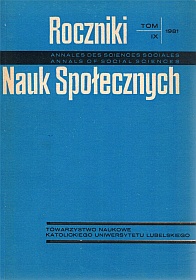The fundamental consensus of the faith in Polish society
Abstract
Starting with a description of the general situation of religion in pre-technical (Christian) and industrial (pluralistic) societies the author tries to estimate, on the basis of the selected sociological studies, the range of the attitudes towards religion characterized by maximal identification (maximal consensus of the faith), partial identification (partial consensus of the faith), minimal identification (minimal consensus of the faith) and by the lack of identification with religion (the lack of consensus of the faith). The picture obtained of the situation in our country is compared to the situation in several West-European countries (Austria, West Germany, Prance, Italy) in the last passages of this study.
Taking into consideration the criterion of the total self-declaration of the people questioned, and the state of the realized religious observances and the criterion of identification with the truths of faith and moral principles of the Church, the author proposes the following division of the consensus of faith in Polish society: maximal consensus of faith-40%, partial consensus of faith-50% (minimal consensus of faith-90%) and the lack of the consensus of faith-10%. The comparisons made in the study show differences in the consensus of faith in Poland and in highly developed West-European countries. There doubtless exists a serious difference between the selective religiousness in Poland and in these countries. But it is rather a difference in the degree and not in the quality of the phenomenon. The ’’western” Catholics among whom religious observances are less developed, seek for more liberal forms of expression to manifest their faith.
Industrial civilization, which-at least indirectly—constributed to the popularization of attitudes partially reserved towards the Church, has made the position of Christianity slightly more difficult. However, the Church retains great social and moral authority which makes it possible to reintegrate attitudes in the direction of the maximal consensus of faith at any time.
Copyright (c) 1981 Roczniki Nauk Społecznych

This work is licensed under a Creative Commons Attribution-NonCommercial-NoDerivatives 4.0 International License.


